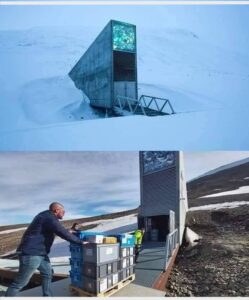Svalbard Seed Vault: The World’s Frozen Insurance Policy for the Future of Food

Hidden away in the Arctic wilderness, beneath thick layers of permafrost and stone, sits one of the most important facilities on Earth—a vault designed to protect humanity’s agricultural heritage. Known as the Svalbard Global Seed Vault, this silent guardian holds millions of seeds from around the globe, ready to help reboot agriculture should disaster ever strike.
A Vault at the Edge of the World
Perched on the Norwegian island of Spitsbergen, within the Svalbard archipelago, the vault is located about 1,300 kilometers from the North Pole. This remote outpost may seem like an unlikely place for the world’s backup pantry, but the choice was far from random. The region is politically stable, geologically secure, and naturally cold—ideal conditions for long-term preservation. Norway’s reputation for neutrality and environmental responsibility makes it an even more fitting guardian for this global treasure.
Why It Exists
Since opening in 2008, the seed vault’s mission has been simple yet profound: to safeguard global crop diversity against any threat—whether that’s war, climate change, plant disease, or natural disaster. While most countries maintain their own seed banks, these can be damaged or destroyed. Svalbard acts as a secure duplicate, a “backup hard drive” for the planet’s food supply.
Unlike regular agricultural storage, the vault is not intended for daily use. It’s a last-resort safety net, ready to step in when local resources are lost forever.
How It Works
Built deep inside a mountainside, the facility benefits from the Arctic permafrost, which keeps it naturally cold even without electricity. This frozen environment allows seeds to survive for centuries. The vault can hold up to 4.5 million different seed varieties—everything from global staples like wheat and rice to rare local crops vital for climate adaptation.
Seeds are sent by countries and organizations in sealed packets, stored at sub-zero temperatures. Importantly, each deposit remains the property of the nation or institution that supplied it—much like a private safe deposit box in a bank.
When It Was Needed
Although designed as an “emergency only” resource, the vault has already proven its worth. During the Syrian civil war, fighting destroyed a vital seed bank in Aleppo. Thanks to earlier deposits in Svalbard, scientists were able to restore lost collections in Lebanon and Morocco—showing that this icy lifeline works exactly as intended.
A Global Effort
Over one million seed samples from more than 70 countries now rest behind Svalbard’s reinforced doors. The vault is jointly managed by the Norwegian government, the Crop Trust, and the Nordic Genetic Resource Center (NordGen)—a partnership that blends political support, scientific expertise, and long-term funding.
A Quiet Beacon of Hope
The Svalbard Global Seed Vault rarely makes front-page news, yet its significance is enormous. It stands as a frozen ark, holding the building blocks of agriculture in case humanity ever needs to start over.
In a world often divided by politics and conflict, the vault represents something rare—global cooperation for the common good. It’s a reminder that our future food security depends on diversity, preparation, and a shared commitment to protecting life’s foundations.
Even in the most remote, icy corners of the planet, hope is stored—one seed at a time.